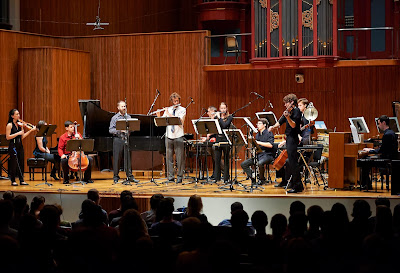Severance
Hall
October
24, 25, 26
 |
| Back at the podium for too much of a good thing. |
Sometimes,
less is more. A small ensemble or a carefully chosen piece can stand
in for something much larger. But the opposite is also true:
Sometimes, more is less. By the final notes on Saturday night, that
was the inescapable conclusion of “Fate and Freedom.”
The
title itself hints at the awkward pairing of the Cleveland
Orchestra’s Beethoven and Shostakovich festival. Two giants who
changed the course of classical music, both engaged with the struggle
for liberty and freedom of expression, each the creator of highly
personal works – these are obvious and well-known parallels. What
Music Director Franz Welser-Möst
hoped to achieve by pairing three sets of their symphonies on
successive nights was a deeper appreciation of their artistic ties
and achievements, and a sense of how great music captures and
reflects its times.
Overload
is one way to accomplish this, though a fatiguing choice. Any one of
the symphonies that Welser-Möst
chose (Beethoven Nos. 3, 4 & 5, Shostakovich
Nos. 6, 8 & 10) is a lot to absorb and
digest. Two is a package that offers interesting contrasts. Six
within the space of 72 hours is like going through a museum on roller
skates, even with a fat program book that included an enlightening
essay by Welser-Möst,
smart observations by visiting commentator Frank Oteri, and the usual
fine background and analysis for each of the pieces.
More
consistent performances that showcased a continuity of ideas would
have helped. After three months away from the orchestra, Welser-Möst
seemed rusty on opening night, starting with a flaccid Beethoven
Symphony No. 3 (“Eroica”) that didn’t take on heroic
proportions until the final movement. The conductor’s
Beethoven is usually delightful – light and nimble yet very
dynamic, with room for details to blossom and ideas to develop,
carefully balanced between expression and technical finesse. But in
this performance the ardor seemed strained, and the message confused.
Is heroism a grand ideal? Or a burden? Or a false hope? Despite some
fine solo work by individual players, it was hard to tell.
Shotakovich’s
Symphony No. 6
poses its own internal challenges, with a long, tense first movement
that gives way to animated, even playful second and third movements.
Welser-Möst
captured the tension very well and maintained a beautiful
transparency through the late cacophony, but overall the piece lacked
cohesiveness. Were the cheerful second and third movements supposed
to ring hollow? Is it all about the censors with Shostakovich, or
something deeper? Again, it was hard to tell.
The
Friday night concert was the best of the three. From the opening
notes, Beethoven No. 4
had what No. 3
lacked – depth, vibrancy, a commanding voice and radiant glow.
Welser-Möst
wove in dark tones that kept the piece anchored, and conducted with
clockwork precision; even the disparate, exuberant elements of the
fourth movement were a seamless fit. If the symphony didn’t have
much to say about either fate or freedom, it nonetheless offered a
revealing portrait of the composer’s personality and musical
development.
Welser-Möst’s
Shostakovich tends to be less fiery than most, a trait that worked to
good effect in No. 8, which the conductor approached
as an outcry against the horrors of World War II. Within that
framework he crafted fine textures and gradations of sound, soulful
solos, and a dazzling range of colors and emotions. The first
movement ended like a tone poem, while the second had a reeling,
almost dizzying quality, and the third conclusively demonstrated that
the Cleveland Orchestra can rock. The concluding movements were like
smoke drifting over a battlefield, punctuated by seemingly random,
inchoate sounds with an undercurrent of loss and despair. One may or
may not agree with Welser-Möst’s
interpretation, but it was presented with clarity and conviction.
The
Saturday concert drew a sellout crowd, largely on the appeal of
Beethoven No. 5,
which offered the most heartfelt performance. Welser-Möst’s
Beethoven is always textbook-clean and elegantly understated. This
piece also had a rich emotional warmth and air of nobility that put
it more squarely in the thematic frame of the festival, reflecting
the composer’s determination not to let his encroaching deafness
dim his highest aspirations. It was the most economical and yet most
powerful of the Beethoven symphonies.
Shostakovich
No. 10
is a technical tour de force that Welser-Möst
painted on a broad canvas, ranging from an almost docile introduction
to some of the most incendiary passages of the entire festival. The
first movement was so delicately done, with low murmurs weaving a
hypnotic spell before rising to dissonant flashes, that there was an
audible exhale of breath in the audience when it finished. The
slicing strings of the second movement and repeating motifs of the
third turned up the burners, which were muted for a bright, nuanced
finale. Perhaps less despairing than Welser-Möst
intended, it was still a remarkable synthesis of the composer’s
hopes and fears.
So
what did we learn? Essentially, that these two towering figures
shared similar passions heavily shaped by their eras and
circumstances. The contrasts were interesting and the occasional
points of intersection revealing, though not with any remarkable new
insights. Mostly, it was an opportunity to hear Shostakovich pieces
that don’t get performed nearly as often as they deserve.
But
then, audiences come out for Beethoven, not Shostakovich. So as a
marketing move, it was brilliant. And a successful exercise in
tempting fate.
For
more on the festival:
http://www.clevelandorchestra.com/event-detail/2013-Oct-24-TCO.aspx?pid=11052
Photo by Roger Mastroianni









